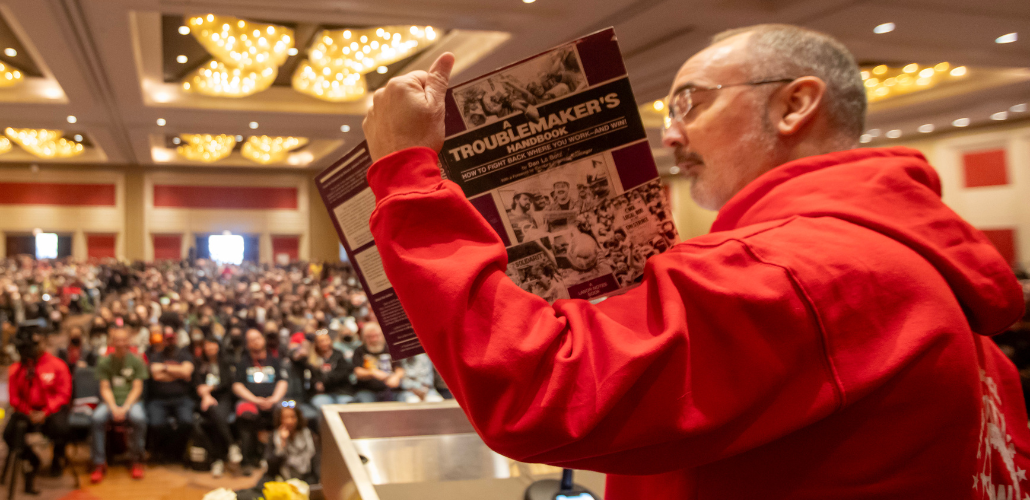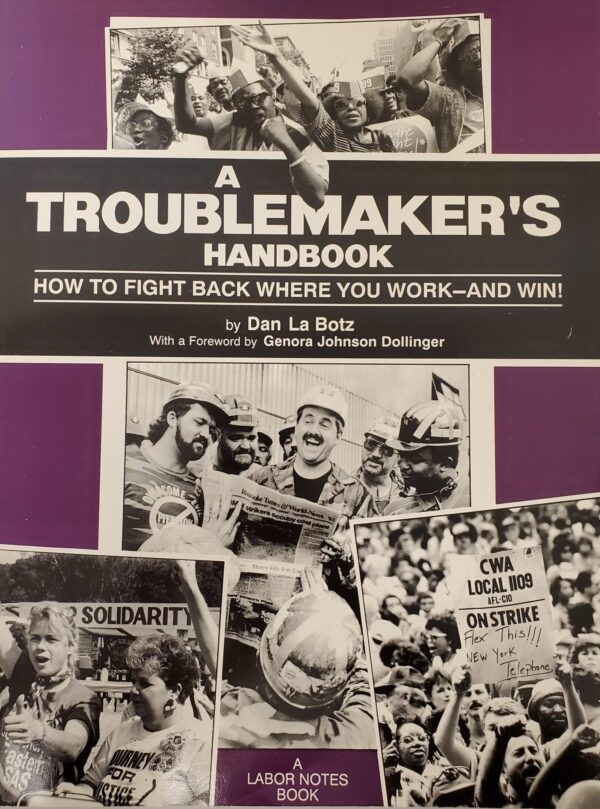The Origin of A Troublemaker’s Handbook

UAW President Shawn Fain held up a dog-eared copy of a Labor Notes classic, A Troublemaker's Handbook, in his closing speech at the 2024 Conference. Photo: Jim West/jimwestphoto.com
United Auto Workers President Shawn Fain recently called A Troublemaker’s Handbook his “other bible.” Author Dan La Botz recalls how this classic Labor Notes book came to be. It was published in 1991 and is now out of print, but available for free download as a PDF. The book was so popular that it later got an all-new sequel, A Troublemaker’s Handbook 2 (2005), and parts of both books live on in the latest Labor Notes bestseller, Secrets of a Successful Organizer (2016). –Editors
In 1990 I received a call from my friend Jane Slaughter at Labor Notes. She said that Rand Wilson, a union organizer and friend of Labor Notes, had come up with an idea for a rank-and-file organizers manual and she wanted to talk to me about it. I drove up to Detroit and had a meeting with Labor Notes staffers Jane, Kim Moody, and Jim West about the proposal.

I agreed that we needed some book to help rank-and-file workers organize, but I thought an organizers manual of the usual sort would be dry and boring. I suggested instead that we interview activists from around the country and let them tell their stories of how they had been successful in organizing around different sorts of issues. Jane took on the task of providing lists of people for me to talk to. With the phone numbers she provided I began to interview people.
Jane and I came up with the topics around which the book would be organized, which would become the book’s chapters. I began to write up the chapters and when I finished one, I would mail the floppy disk to Jane, who would then pop it into her computer, edit it, and return it to me. Jane and I, both journalists and good friends, had a great working relationship. Once she sent back to me a chapter with a note: “This one is no good. Do it over.” Jane was usually right, so I wrote it again.
I wrote and appended to each chapter a set of questions—”Action Questions”—so that readers could ask themselves how they might use such strategies and tactics. Ellis Boal, another friend of Labor Notes and a labor attorney, wrote legal notes where necessary. Jim West provided photographs for the book. I also, over some opposition, pushed for the title: A Troublemaker’s Handbook. As I said at the time, we’re always called “troublemakers,” so let’s own it.

SUPPORT LABOR NOTES
BECOME A MONTHLY DONOR
Give $10 a month or more and get our "Fight the Boss, Build the Union" T-shirt.
Once we had the text together, Dave McCullough designed the book. Genora Johnson Dollinger, leader of the Women’s Emergency Brigade during the auto workers’ 1937 sitdown strike in Flint, kindly wrote the foreword. The book was a real group effort.
Published in 1991, A Troublemaker’s Handbook became a Labor Notes bestseller with more than 25,000 copies sold in the next 15 years at about $17 per copy. The book not only became an organizing tool for workers; it also brought in revenue for Labor Notes.
The book was popular because readers heard other people like themselves explaining how they had solved problems at work and succeeded in beating the boss. Mostly it was individual workers who bought it, but some union locals bought a copy for every member of the executive board or even every steward.
I felt very proud when union activists would come up to me at Labor Notes conferences, shake my hand, and thank me for writing a book which they had used to fight the employers or to reform their local union. My favorite compliment came from a guy who said to me, “I keep the Troublemaker’s Handbook right by the toilet and take a look at it every morning.”
Dan La Botz is the author of several books on labor and politics in the U.S. and Mexico. His latest book is Radioactive Radicals, a novel about leftists in the Teamster union.
